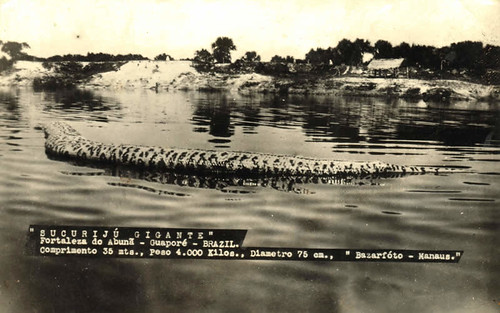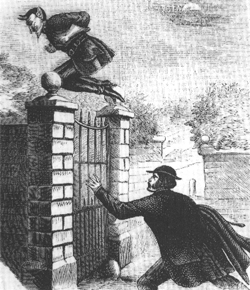
Kongamato is Zambian for "overwhelmer of boats," and describes ferocious flying creatures that lived along the rivers terrorizing fishermen. The engima of the kongamato began in 1923, in which British writer Frank Melland describes the creatures in his book, Witchbound Africa:
"...the wingspread was from four to seven feet across, that the general color was red. It was believed to have no feathers but only skin on its body...teeth in its beak....I sent for two books...containing pictures of pterodactyls, and every native...picked it out and identified it as kongamato."
In 1925, a distinguished English newspaper correspondent, G. Ward Price, was with the future Duke of Windsor on an official visit to Rhodesia. He reported a story that a civil servant told them of the wounding of a man who entered a feared swamp in Rhodesia known to be an abode of demons. The brave native entered the swamp, determined to explore it in spite of the dangers. When he returned he was on the verge of death. He had a great wound in his chest. He recounted how a strange huge bird with a long beak attacked him. When the civil servant showed the man a picture of a pterosaur from a book of prehistoric animals, the man screamed in terror and fled from the servant's home.
In 1942 Colonel C. R. S. Pitman reported stories the natives had told him of a large bat/bird type creature that lived in Northern Rhodesia (now Zambia) in a dense swampy region--supposedly to look upon it was death. Tracks of the creatures were seen, with evidence of a large tail dragging the ground. These reports were not limited to Zambia, but also came from other locations in Africa such as Mount Kilimanjaro and Mount Kenya.
Perhaps the most striking report of living pterosaurs comes not from natives, but from white explorers in the employment of the British Museum. In 1932-3 the Percy Sladen Expedition went to West Africa. In charge of the team was Ivan T. Sanderson, a well-known zoologist and writer. While in the Assumbo Mountains in the Cameroons, they made camp in a wooded valley near a steep banked river. They were out hunting near the river when Sanderson shot a large fruit-eating bat. It fell in the water, and as Sanderson was carefully making his way in the fast moving current, he lost his balance and fell. He regained his balance when his companion suddenly shouted "Look out!"
"And I looked. Then I let out a shout also and instantly bobbed down under the water, because, coming straight at me only a few feet above the water was a black thing the size of an eagle. I had only a glimpse of its face, yet that was quite sufficient, for its lower jaw hung open and bore a semicircle of pointed white teeth set about their own width apart from each other. When I emerged, it was gone. George was facing the other way blazing off his second barrel. I arrived dripping on my rock and we looked at each other. "Will it come back?" we chorused. And just before it became too dark to see, it came again, hurtling back down the river, its teeth chattering, the air "shss-shssing" as it was cleft by the great, black, dracula-like wings. We were both off-guard, my gun was unloaded, and the brute made straight for George. He ducked. The animal soared over him and was at once swallowed up in the night."
In 1956 in Zambia along the Luapula river, engineer J.P.F. Brown was driving back to Salisbury from a visit to Kasenga in Zaire. He stopped at a location called Fort Rosebery, just to the west of Lake Bangweulu, for a break. It was about 6:00 p.m. when he saw two creatures flying slowly and silently directly overhead. He, bewildered, observed that they looked prehistoric. He estimated a wingspan of about 3-3 1/2 feet, a long thin tail, and a narrow head, which he likened to an elongated snout of a dog. One of them opened its mouth in which he saw a large number of pointed teeth. He gave the beak to tail length at about 4 1/2 feet. After this report came out, a couple by the name of Mr. and Mrs. D. Gregor reported that they had seen 2 1/2 ft. long flying lizards in Southern Rhodesia, and a Dr. J. Blake-Thompson reported that natives of the Awemba tribe had told of huge flying creatures resembling rats that would attack humans. They lived in caves in cliffs near the source of the great Zambezi River.
Skeptics tend to disagree with the existence of the kongamato, and claim that the Saddle-bill stork and the Shoebill stork are the actual sightings. Whether the reports are of actual sightings of pterosaur-related creatures, or if it they represent some unknown (to science) huge sort of bat or bird with a bad attitude, perhaps time will tell. Of all the remote, inaccessible locations in the world where unknown creatures could still exist, probably the best candidates would have to be the deep enormous swamps in Africa. These swamps are so overgrown with vines and undergrowth that human travel is next to impossible.
Sightings still occur today, but the most abundant of them ended in 1957.
Source:
Serrett, Cisco. "Kongamato." Cryptozoology Cryptids. http://www.cryptozoology.com/cryptids/kongamato.php






